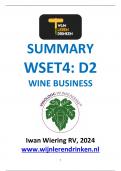Summary
WSET4 Diploma Course summary: D2 Wine Business
- Course
- Institution
In 2024 I wrote this summary for the D2 book (Wine Business) to the WSET level 4 Diploma Course and scored a pass. I hope you will enjoy the benefits and wish you good luck with your exams to the level 4 Diploma.
[Show more]



